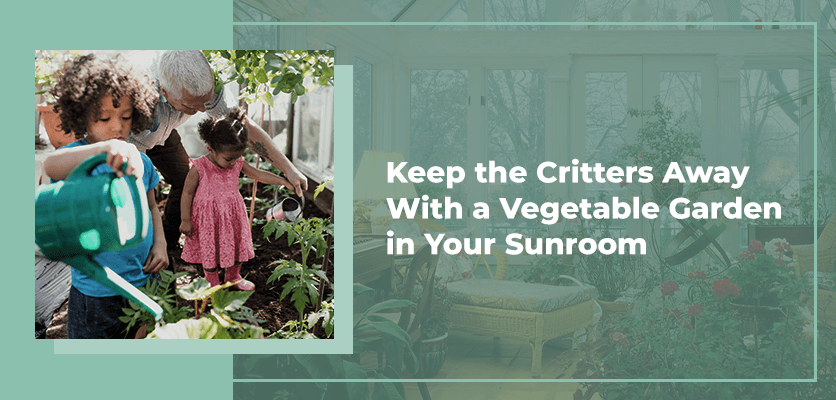
If you’ve always wanted a vegetable garden but worry about critters eating your crops, sunrooms are the perfect solution. Sunrooms create an enclosure around your garden so rabbits, squirrels and bugs can’t gnaw away at your hard work.
Sunrooms get sunshine all year, making them one of the top places to grow vegetables. Showcase your green thumb by learning how to grow vegetables indoors.
Why a Sunroom Is a Great Place to Grow Vegetables
Sunrooms are an excellent place to grow veggies indoors since you don’t have to worry about animals or bugs getting in and eating your crops. Some reasons to choose a sunroom for your indoor vegetable garden include:
Provides Natural Sunlight
Vegetables and plants need plenty of sunlight to grow, which can be challenging if you try to grow your plants indoors. However, a sunroom makes it easy to let natural light in, allowing your indoor garden to get plenty of light to maximize crop yield. You can choose from different configurations for your sunroom to get the most light possible, giving your vegetables the best chance to thrive.
Shields Plants From Pests
One of the main benefits of growing your plants in your sunroom is that it creates a shield from pests. Bugs and critters can eat away at your crops, which can be frustrating after spending so much time and effort growing your vegetables. Growing your vegetables in a sunroom also eliminates the need for pesticides. Planting vegetables in your sunroom makes gardening more enjoyable and creates less hassle.
Protects Plants From Excess Rain
Your plants need a specific amount of water to grow efficiently. However, it can be challenging to control how much water your vegetables get when exposed to the outside elements. Excessive rain can overwater your plants, which reduces the oxygen in the soil and damages the roots, so they cannot take in the water they need.
A sunroom allows you to control the water your plants get daily, giving them a better chance to flourish. You won’t have to worry about your plants dying from excessive rainfall.
Regulates Temperature and Humidity
Many plants have recommended temperatures and humidity levels for growth, but it can be challenging, if not impossible, to control temperature and humidity levels when you’re planting your vegetables outdoors. Planting your crops in a sunroom allows you to control the temperature and humidity levels inside, which makes it easier to successfully grow vegetables indoors. You can even grow vegetables year-round, which helps you maintain a consistent supply of vegetables for you and your family.
Vegetables You Can Grow in Your Sunroom
Learning how to grow your own food year-round is a fantastic way to access affordable produce for you and your family. Sunrooms allow you to grow a diverse selection of vegetables indoors, including:
- Tomatoes: Tomatoes are the perfect plant to grow inside, especially with innovations like the Topsy Turvy Tomato Grower that reduces how much floor space you need to use to grow your plants inside. Tomatoes only need access to sunlight, big pots, and cages or stakes to keep the branches upright while the plant grows. You can also choose dwarf tomatoes, which can be grown in containers, taking up even less space in your sunroom.
- Carrots: Carrots are another excellent option for growing in your sunroom. Carrots prefer cooler environments, so sunrooms make the best environment for growing these vegetables compared to hot outdoor environments. All you’ll need is a deep pot since carrots are root vegetables and will need plenty of space for their roots to grow.
- Peppers: Small peppers are an excellent vegetable to grow inside. These vegetables need peak sunlight, so you’ll want to place them in a spot in your sunroom that gets the most access to natural light. You can grow different varieties of small peppers, including shishitos and chili peppers.
- Scallions: Scallions are low-maintenance vegetables that are easy to grow, making them a good choice for growing inside your sunroom. These vegetables grow quickly, and you can use seeds or regrow from past scallions, making them a more sustainable plant. You can easily regrow scallion scraps you’ve used in a recipe by using sunlight, water, soil and a pot.
- Kale: Kale can be grown in many ways, including microgreens, sprouts, baby salad greens or full-sized plants. You can choose which type of kale you want, depending on your ideal maturity times. For example, sprouts are quick and easy, while a full-sized kale plant will take more time. Depending on how you grow kale, you only need a tray or a pot, sunlight and water.
As you gain experience growing these vegetables in your sunroom, you can start experimenting with other plants. Soon, you’ll have a thriving vegetable garden in your sunroom!
Start Gardening Today With a New Sunroom From PAsunrooms
Indoor vegetable gardens are a great way to supplement your diet. Sunrooms are one of the best places in your home to grow vegetables, and PAsunrooms can help you create a stunning additional space for the garden in your home. We offer various sunroom solutions, including glass enclosures and Four Seasons sunrooms, that can help you control temperatures while creating a space to entertain. Contact us online or call us at 717-564-2244 to get in touch with our team.







